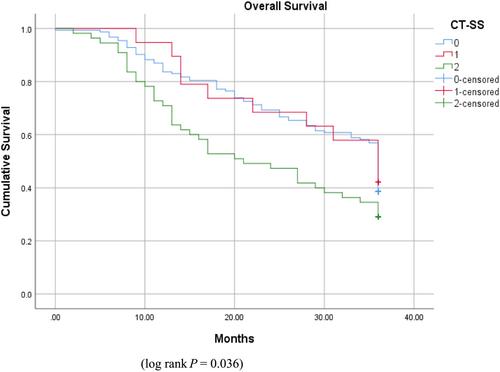Thought to capture the nutritional and functional reserve of the cancer patient, whether the computed tomography (CT)-derived sarcopenia score (CT-SS) has complimentary prognostic value to commonly utilized pre-treatment host assessments in patients with oesophago-gastric (OG) cancer is unknown. The aim of the present study was to examine if the CT-SS can stratify survival in OG cancer patients with good performance status [Eastern Cooperative Oncology Group Performance Status (ECOG-PS) 0/1]. Furthermore, if the CT-SS had complimentary prognostic value to cardiopulmonary exercise testing (CPET) performance and systemic inflammation.
Consecutive patients with confirmed OG cancer and good performance status, who received neoadjuvant chemotherapy (NAC) with a view to surgical resection with curative intent, between 1 January 2010 and 31 December 2015, within NHS Greater Glasgow and Clyde (NHSGGC) and NHS Forth Valley (NHSFV), were identified from a prospectively maintained database. CT-SSs were grouped as 0/1/2. CPET variables recorded included VO2 anaerobic threshold (AT) and peak. Systemic inflammatory response was determined by modified Glasgow prognostic score (mGPS) and neutrophil/lymphocyte ratio (NLR). Associations between categorical variables were examined using χ2 test and binary logistics regression analysis.
A total of 232 patients met the inclusion criteria. 75% (n = 174) of patients were male, 54% (n = 126) were 65 years or older, and 60% (n = 139) were overweight [body mass index (BMI) ≥25 kg/m2]; 33% (n = 77) of patients had CT-SS ≥ 1, 36% (n = 83) had a low VO2 AT (≤11 ml/kg/min), and 57% (n = 132) had a low VO2 peak (≤19 ml/kg/min). Of the 200 patients who had pre-NAC bloods facilitating calculation of the mGPS, 28% (n = 55) had mGPS ≥ 1. Of the 211 patients who had pre-NAC bloods facilitating calculation of NLR, 38% (n = 80) had an NLR ≥ 3; 82% (n = 190) and 53% (n = 122) were alive at 1 and 3 years post-NAC, respectively. On univariate analysis, CT-SS was significantly associated with sex (P < 0.05), histological cell type (P < 0.05), low VO2 AT (P < 0.05), low VO2 peak (P < 0.05), BMI (P < 0.05), mGPS (P < 0.05), and 3-year survival (P < 0.05). On multivariate analysis, tumour, node, and metastasis (TNM) stage (P < 0.05) and CT-SS (P < 0.05) remained significantly associated with 3-year survival. CT-SS was significantly associated with 3-year survival in patients who had mGPS 0 (P < 0.05), but not low VO2 AT (P = 0.066) or peak (P = 0.065).
The CT-SS would appear to capture the nutritional and functional reserve of the patient and is a useful objective measure for stratifying long-term survival in patients with good performance status undergoing potentially curative treatment for OG cancer.


